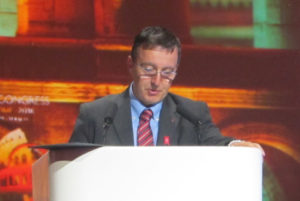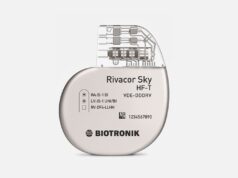
Two randomised clinical trials presented at a Hot Line session of the European Society of Cardiology Congress (ESC; 27‒31 August, Rome, Italy) have shown that remote monitoring of cardiac implantable electronic devices (CIEDs) did not reduce mortality or hospitalisations in heart failure patients. Physicians at ESC argued that this is not the “end” of remote monitoring for heart failure but rather a call to develop next-generation devices with better algorithms to help triage alerts and simplify interpretation of data, perhaps directed to impact clinical outcomes.
The world’s largest remote monitoring study of patients with CIEDs, REM-HF (Remote management of heart failure using implantable devices), showed that remote monitoring was not associated with reduced mortality or fewer cardiovascular hospitalisations compared to usual care. Likewise, results of MORE-CARE (Monitoring resynchronisation devices and cardiac patients) demonstrated no reduction of mortality or risk reduction of cardiovascular or device-related hospitalisation compared to in-office follow-ups; however, it showed a reduction in healthcare costs.
Nevertheless, a meta-analysis of the IN-TIME, ECOST and TRUST trials—also presented at ESC—suggested a mechanism of clinical benefit with remote monitoring of implantable cardioverter defibrillators in heart failure patients. The results showed reduced all-cause death and reduced worsening heart failure hospitalisation and all-cause of worsening heart failure death.
REM-HF trial
“To date, randomised controlled trials of remote monitoring have had variable results, presumably depending on patient characteristics, the monitoring technology, and the responses taken to data collected,” said co-principal investigator of REM-HF Martin Cowie (Imperial College London, Royal Brompton Hospital, London, UK). “So we wanted to assess in a pragmatic study of a care pathway, informed by weekly remote monitoring of typical CIEDs, to determine the effect on mortality and hospitalisation in heart failure patients.”
REM-HF was a multicentre, prospective, randomised, non-blinded controlled trial comparing usual care plus weekly remote monitoring with usual care alone, which included remote monitoring of the device functionality every three or six months.
In total, 1,650 heart failure patients (824 for usual care and 826 for remote monitoring) were enrolled from September 2011 to March 2014 at nine hospitals in England. The median follow-up was 2.8 years. The patients had an average age of 70 and had one of three types of CIEDs: implantable cardioverter defibrillator (ICD), cardiac resynchronisation therapy device with defibrillator (CRT-D) or cardiac resynchronisation therapy device with pacemaker (CRT-P) from Medtronic, Boston Scientific and St Jude Medical and were equipped for remote monitoring.
There were no meaningful differences between the two randomised groups. Cowie noted that patients were “very well” medically treated for heart failure with more than 90% of patients with angiotensin converting enzyme (ACE) inhibitors or angiotensin receptor blockers (ARB), over 90% with beta-blockers and over 50% with aldosterone antagonist.
The primary endpoint of the study determined by death from any cause or unplanned hospitalisation for cardiovascular reason showed no meaningful differences between the two arms (hazard ratio 1.01 [0.87-1.18] p=0.87). Cowie noted that none of the baseline characteristics including: age, gender, New York Heart Association class, type of device, history of coronary artery disease or history of atrial fibrillation, identified a group in which remote monitoring was more effective than usual care alone.
In conclusion, Cowie said: “Despite the technical capacity of remote monitoring to provide almost a continuous stream to us clinicians and decision makers, I do not think the transmission of data weekly in the usual system of care—maybe it is confined to England—including that additional extra work and training translates into meaningful improvement for our patients with these hard endpoints.”
“Although some studies investigating a range of remote monitoring strategies have suggested potential benefit, and adoption of remote monitoring is quite widespread, results of the REM-HF trial offer a new perspective that has the potential to change clinical practice,” commented co-principal investigator of the study John Morgan (University of Southampton, Southampton, UK). “Our trial is distinct in its design, comprising multiple manufacturers’ devices, with monitoring occurring in the patients’ usual care centres, and with potentially pre-emptive care interventions driven by observation of trends seen over the course of routine weekly downloads of multiple diagnostic variables.”
Haran Burri (University Hospital of Geneva, Geneva, Switzerland), discussant of the trial at ESC commented: “Is REM-HF the last nail in the coffin of remote monitoring? I do not think so, remote monitoring is the standard of care in many places, it is convenient both for patients and care givers and it has benefits such as reductions of inappropriate shocks.”
Burri stressed the point that with REM-HF there was a lot of information, “perhaps too much, which meant that it was probably too difficult to interpret and then to perform meaningful actions.” He noted that in the weekly remote monitoring there were more than 45,000 transmissions. “Less than 8% of the transmissions actually led onto an action and there were <0.5% of medication changes by the monitor. There may have been more medications changes made by in-office visits but very few direct medical actions taken by the transmissions themselves.”
He suggested that using data management—such as integrated diagnostics algorithms in remote monitoring—may help triage alerts, simplify interpretation of data, risk stratify patients and perhaps impact also patient’s outcome, “but that remains to be proven,” he noted.
At a Meet the trialists session of ESC, Cowie commented that he hopes the next generation of remote monitoring technology would be developed to identify what is important in all the data streams and also enable nurses, technologists and physicians to know what action to take at the right time.
MORE-CARE trial

The MORE-CARE (Monitoring resynchronization devices and cardiac patients) prospective, multicentre, randomised controlled trial was aimed to evaluate the clinical and economic value of remote monitoring compared with standard follow-up strategies in heart failure patients implanted with a CRT-D with advanced diagnostics from Medtronic.
The study, presented by lead investigator Giuseppe Boriani (University of Modena and Reggio Emilia, Policlinico di Modena, Modena, Italy) and published simultaneously in the European Journal of Heart Failure, was terminated early due to slow recruitment during five years, making it underpowered to evaluate its primary endpoint of mortality and hospitalisations for cardiovascular or device-related reasons.
Boriani commented that they had planned to recruit 1,720 patients and in the end 865 patients (mean age 66±10 years), from 61 cardiology centres in nine countries from Europe and Israel, were randomised to undergo remote checks alternating with in-office follow-ups (remote arm, 437 patients) or in-office follow-ups alone (standard arm, 428 patients) within eight weeks of device implantation.
After a median follow-up of two years, 253 patients reached the primary endpoint 130 (29.7%) in the remote arm and 123 (28.7%) in the standard arm. The results showed no significant differences in the individual components of the primary endpoint (p>0.05). Boriani noted that the most frequent component of the primary endpoint was cardiovascular hospitalisations with Kaplan-Meier two-year estimates of 27.3% in the remote arm and 26.7% in the standard arm.
The composite endpoint of healthcare resource utilisation, which included two-year rates of cardiovascular hospitalisations, cardiovascular emergency department admissions and cardiovascular in-office follow-ups, found a 38% reduction in the remote arm compared with the standard arm. Specifically, Boriani noted, the healthcare resource cost-saving from remote monitoring was €2,899 per 100 patients at two years, driven almost entirely by the reduction in scheduled office visits (incident rate ratio (IRR): 0.59, 95%CI 0.56-0.62, p<0.001). This was despite a slightly higher rate of unscheduled visits in the remote arm (IRR: 2.80, 95%CI 2.16-3.63, p<0.001). In addition, there was a travel cost-saving of €145 per patient over two years resulting from remote monitoring.
In the European Journal of Heart Failure, Boriani et al highlight the “favourable profile” of remote monitoring in terms of costs from the perspective of both the healthcare system and that of the patient. “This may be a valid reason for implementing remote monitoring despite the lack of impact on hard clinical outcomes. Moreover, remote monitoring may be more efficient than traditional in-office follow-up with allocation of resources to other tasks,” the authors wrote.
Commenting on the neutral results in clinical outcomes of REM-HF and MORE-CARE, Renato Pietro Ricci (San Filippo Neri Hospital, Rome, Italy), member of the Steering Committee of MORE-CARE told Cardiac Rhythm News: “The results of these studies do not mean that remote monitoring is not useful in improving management of heart failure patients. The key points to be developed and investigated now onwards are the improvement of diagnostic capabilities of remote monitoring with new tools aimed at identifying patients who actually need timely clinical intervention; and the implementation in clinical practice workflow models and reaction to alert protocols capable of improving quality of clinical reaction to pending heart failure events.”
TRUECOIN meta-analysis

At an ESC session on remote monitoring of implantable devices, Gerhard Hindricks (Leipzig Heart Center, Germany) presented the results of the TRUECOIN study, a meta-analysis which pooled data from 2,405 patients enrolled in the TRUST, ECOST and IN-TIME trials. Hindricks reported that remote monitoring with Biotronik Home Monitoring was associated with a 38% reduced risk for all-cause mortality after one year in all ICD patients.
These results were observed in comparison with conventional office follow-up alone and also found a 36% reduction in the combined risk of all-cause mortality or hospitalisation for worsening heart failure.
“In principle, all ICD and CRT manufacturers provide devices with remote monitoring features but significant differences exist with respect to system technologies, system feasibilities, data acquisition capabilities, process and workflow options,” commented Hindricks. “These system differences may have a significant impact on their feasibility to improve medical treatment and affect outcome.”









